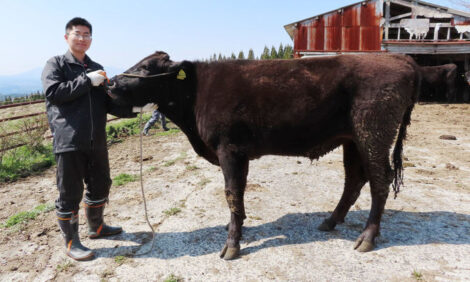



Microalgae suitable substitutes for soy and faba beans in feeding dairy cows
As indicated by studies carried out at the University of Helsinki, there are no biological or physiological obstacles to using microalgae as a protein feed for dairy cattle“Even though microalgae seem to be well-suited to substitute for soy and faba beans in feeding dairy cows, their feed value most likely falls slightly below rapeseed in terms of milk output and nitrogen utilisation,” says Marjukka Lamminen, a doctoral candidate at the Faculty of Agriculture and Forestry.
In her doctoral dissertation, Lamminen assesses the potential of various microalgae as protein feeds for dairy cows. Four feeding experiments were conducted to investigate the impact of different feeds on feed consumption, milk production, energy metabolism, nitrogen utilisation and amino acid metabolism.
In the experiments, the Spirulina platensis, Chlorella vulgaris and Nannochloropsis gaditana microalgae substituted for the protein found in conventional protein feeds (rapeseed meal, soybean meal and faba beans) either wholly or partially. Furthermore, the effect of protein feeding on milk yield and metabolism was investigated in one of the experiments.
Cows didn’t have an appetite for microalgae
The palatability of microalgae was clearly poorer than that of conventional protein feeds. When roughage and concentrate were fed to the cows separately, the intake of concentrates containing microalgae decreased, but the cows compensated for this by eating more roughage. As a result, the total intake of feed did not change when microalgae were used as a substitute for conventional protein feeds. When offered as total mixed ration, the cows ate less feed overall, as they were unable to avoid microalgae.
Minor effects on milk production
With the Spirulina platensis microalgae partially substituting for the protein found in rapeseed or faba beans, milk output decreased in conjunction with rapeseed feeding, but increased in conjunction with faba bean feeding. Similar effects were observed in the production of milk protein. Milk and milk protein yields achieved through microalgae feeding were comparable to those achieved through soybean feeding. Substituting rapeseed and soybeans with Spirulina platensis increased milk fat yields, possibly due to differences in rumen fermentation, a decrease in the body weight of the cows or an increased intake of methionine, an amino acid.
Protein feeding increased nitrogen excretion into the environment and reduced protein utilisation in milk production
The protein concentration of the Spirulina platensis and Chlorella vulgaris microalgae was notably higher compared to the crude protein of conventional protein feeds, approximately 600–700 g/kg in dry matter, while the protein concentration of Nannochloropsis gaditana, 385 g/kg in dry matter, corresponded to that of conventional protein feeds. The effect of microalgae on nitrogen utilisation depended on the substituted conventional protein feed.
When Spirulina platensis substituted for rapeseed, the effect was negative, as a smaller share of the nitrogen and human-edible protein in the feed ended up in the milk. With rapeseed feeding, the utilisation rate of protein suitable for humans was 150% at its highest, which means that cows fed with rapeseed produced more human-edible protein in their milk than what they consumed in the feed. Therefore, rapeseed feeding promoted food security due to the fact that rapeseed meal is a by-product of food production with a very good milk yield response. With microalgae feeding, the corresponding ratio was approximately 100%, making the impact of microalgae on food security neither positive nor negative.
When microalgae substituted for faba beans or soybeans, the effects were more positive compared to rapeseed feeding, as the proportion of nitrogen ending up in the milk increased or remained unchanged. The utilisation rate of human-edible protein was approximately 80% with soy and faba bean feeding. In other words, cows fed with these feeds consumed more human-edible protein in their feed than they produced in their milk. Thus, these feeding types may impair food security compared to rapeseed and microalgae. Nitrogen excretion into urine also decreased, as microalgae substituted for soybeans in feeding dairy cows. The opposite effect was seen when microalgae substituted for faba beans, as the total excretion of nitrogen into the environment increased.
Further research needed on the effect of microalgae on amino acid metabolism
Of the microalgae amino acids, the concentration of histidine was lower and that of methionine higher compared to conventional protein feeds. The availability of these amino acids is often the first factor limiting the milk yield of dairy cows. In all of the experiments, microalgae decreased the cows’ histidine intake, while increasing the intake of methionine. Lamminen believes that further research is needed to look into the effect of microalgae on amino acid metabolism.


